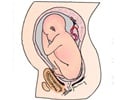
The turning procedure, called an external cephalic version, or simply a "version," can allow some women with breech babies to avoid a cesarean section and have a head-first vaginal delivery instead. Prior studies have shown that spinal or epidural anesthesia — similar to the anesthetic techniques offered during childbirth — can help more babies to be turned successfully. Many obstetricians still do not use anesthesia when doing a version.
"We've been looking at reasons physicians don't offer anesthesia during this procedure, and one reason may be that they think it may add extra costs," said the study's lead author, Brendan Carvalho, MD, associate professor of anesthesia at Stanford and chief of obstetric anesthesia at Packard Children's. "But our work shows that it doesn't add significant costs, and most likely reduces overall costs because more women can avoid cesareans."
The study was published online today in Anesthesia & Analgesia.
Because a breech vaginal delivery, in which a baby is born feet-first or bottom-first, is more dangerous for the mother and baby than a head-first vaginal delivery, many breech babies are delivered by cesarean section. But cesarean sections have their own disadvantages, such as increased risk of maternal hemorrhage, more pain and longer recovery times for the mother after birth, as well as higher hospital costs. As part of their effort to reduce cesarean rates, Packard Children's obstetric anesthesiologists have been offering anesthesia during version procedures for the last two years, making Packard Children's a Bay Area leader in studying and providing anesthesia for versions.
The new research drew upon data from several earlier studies that compared version success rates with and without anesthesia. The scientists also used national data on the cost of the version procedure with and without anesthesia, and the costs of vaginal and cesarean deliveries. All of the data was entered into a mathematical model that allowed the scientists to predict whether anesthesia use during a version was cost-effective.
Advertisement
Looking at the question of cost-effectiveness in a different way, the success rates of versions had to be improved at least 11 percent with anesthesia for the cost of the anesthesia to be negated, the researchers calculated.
Advertisement
Abdominal muscle relaxation likely contributes to the higher success rates of the procedures performed with anesthesia, Carvalho said, adding that muscle relaxation caused by anesthesia may allow practitioners to apply less pressure to turn the baby. A previous study by these investigators demonstrated that anesthesia does not increase the risk of performing a version.
Source-Eurekalert












